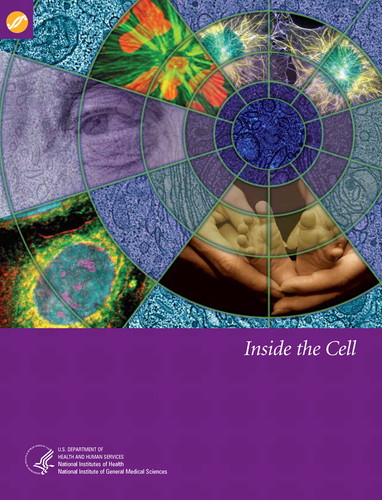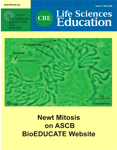Matters of Life and Death: A Cellular Tour Informed by Basic Research
From my work in a science museum, I can tell you that most adults have heard of cells, and can rattle off something about “building blocks of living things” when asked about them. But probe a bit deeper, and anyone who's not had reason or opportunity to study cells in any depth will take on that “deer in the headlights” glaze and find a convenient exit from the conversation. Visualizing anything microscopic is always a challenge, and the fact that we're composed of some 50 trillion individual cells (give or take) which are in turn composed of all those tongue-twisting parts and pathways, well…it's no wonder that cells are often regarded as confusing, mysterious, and esoteric.
The booklet Inside the Cell by the National Institutes of Health and the National Institute of General Medical Sciences provides an excellent primer on the fundamental roles of cells in the life and death of human beings. It succeeds in introducing the basic structure and functions of human cells in an engaging, reader-centered narrative, illuminated with superb illustrations, photomicrographs, and supplemental online videos. Frequent sidebars highlight recent and ongoing research that makes direct connections between basic research and human health, development, and disease. The material is geared to a late high school or early college audience, or the interested nonspecialist. For those whose knowledge of cell biology is a bit rusty, the booklet provides a solid overview of new technologies, ranging from quantum dots to microarrays.
Figure 1. Cover of Inside the Cell.
Chapter 1, “An Owner's Guide to the Cell” deals with the issue of scale by shrinking the reader to one three-millionth of their size. The scenario works by providing a reference point to real-world objects. For example, the microscopic reader would observe that the typical human cell has the dimensions of a football field. The opening tone of this chapter may be a bit off-putting to the reader, as it is more appropriate for an elementary or middle school child (e.g., “…don't worry, you'll return to your normal size before you finish this chapter”), but the tone becomes more mature after a few pages, when the science becomes the main focus. The analogies of cellular organelles are those one expects (e.g., mitochondria as power plants), but the illustrations are a delightful surprise—real micrographs, some with digitally colored structures or highlighted with fluorescent dyes bring the dynamic cells into sharp focus. The chapter closes with a science controversy, that of the origin of the Golgi. Two theories are presented, and supplemented with animations on the website. The inclusion of evidence that supports two competing theories provides an excellent example of the scientific method in action.
Energy generation, protein synthesis and traffic, and molecular motors are the focal points of the second chapter “Cells 101: Business Basics.” Chapter 3 does an admirable job of introducing cellular differentiation, and incorporates a discussion of stem cells. A favorite classroom organism, the planarian, is presented as a model system to study regeneration. Differentiation of neurons is discussed, with particular connection to the senses and the cascades of chemical reactions that allow us to sense our world. This chapter ends with a nod to “omics” and computational biology.
Cellular reproduction is the focus of Chapter 4, and the authors should be congratulated for including an excellent, 2-page, side-by-side diagrammatic comparison of mitosis and meiosis. Chapter 5 is aptly titled “The Last Chapter: Cell Aging and Death.” Telomeres, antioxidants, and apoptosis illustrate what we know, and how much we don't know, about cellular aging and death. Just before the glossary, five cell biology researchers are highlighted, each with a link to websites for additional information about their work.
There is much to recommend in this booklet for the formal educator. I provided the booklet to high school teachers who participated in my professional development classes during the summer of 2008. Comments from the teachers were very positive, and many of them planned to adopt it as a supplement to their textbooks for a variety of reasons, including: 1) the text is not terminology-heavy, and as such allows for a better flow of the narrative story; 2) the glossary at the end of the booklet clearly and succinctly defines approximately 80 terms with which some readers may not be familiar; 3) the illustrations and their captions, including micrographs that are color enhanced for clarity, are highly accessible to students; and 4) the drawings of proteins clearly illustrated the importance of three-dimensional structure in protein function.
The inclusion of videos in the online supplements was of high interest to the teachers. The four different movies of the Golgi provide a realistic three-dimensional view of the organelle and a much more accurate illustration of just how packed with “stuff” cells are than is illustrated in standard textbook diagrams. The research stories highlighted the impact of basic research on issues near and dear to the hearts of the audience. For example, the study of telomerase is linked to potential diagnostics or cures for cancer, a disease that touches, directly or indirectly, virtually everyone. RNAi is introduced as something whose study may lead to a new class of anti-AIDS drugs. Each chapter closes with a series of self-assessment questions to see if the reader “got it,” something that could easily be adapted to classroom pre- or postlesson assessments. While the focus of the publication is on human cells, which is reflective of the work of researchers funded by NIH, the human-centered focus is most engaging for the teenage audience and much of the information can be applied to other cell types as well.
Inside the Cell can be read online or downloaded (PDF or HTML) for free. Individuals can order one free print copy, and teachers can order up to 30 free copies for classroom use. Its emphasis on real images and videos, and connections of research to issues of human health and disease, make it a compelling educational tool.



